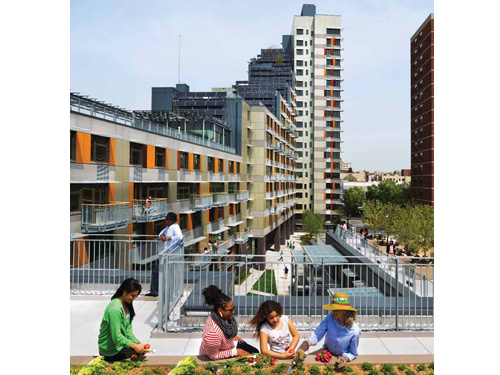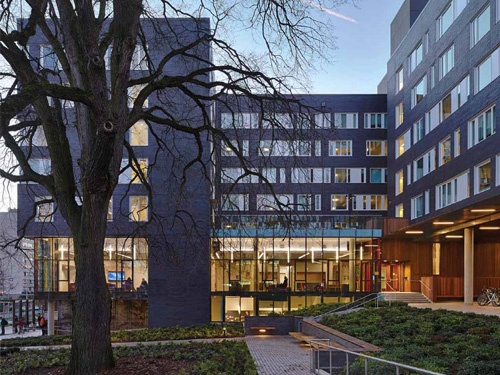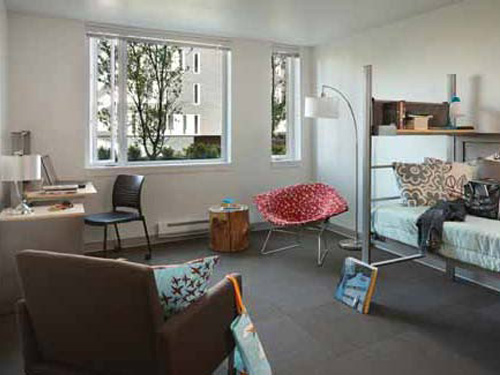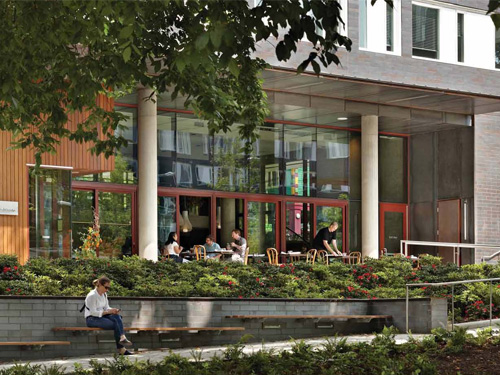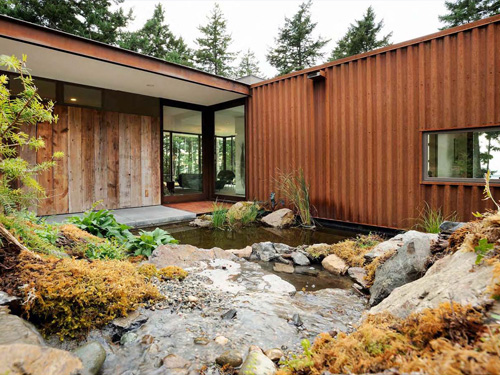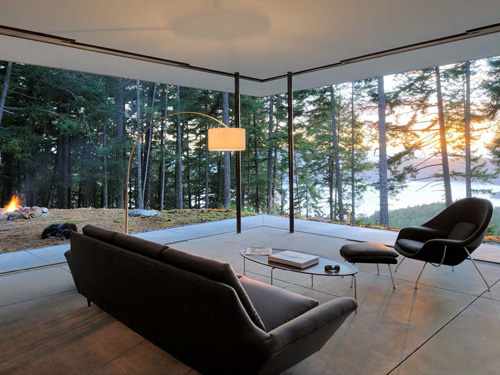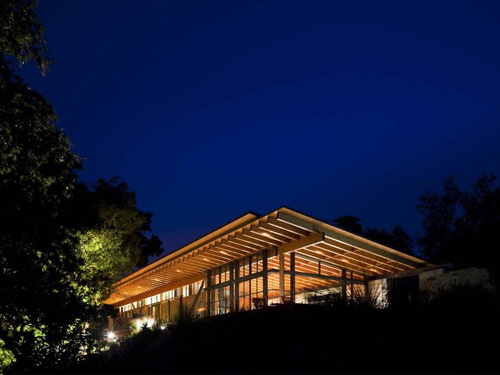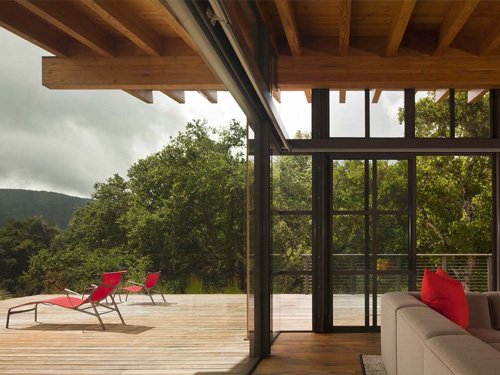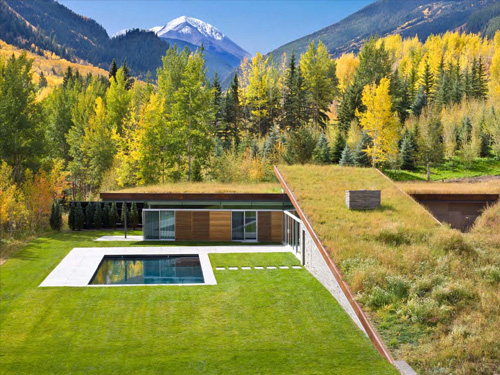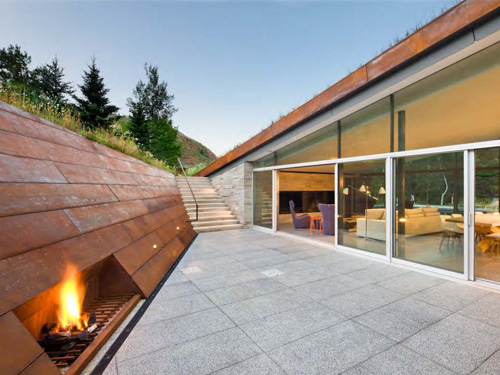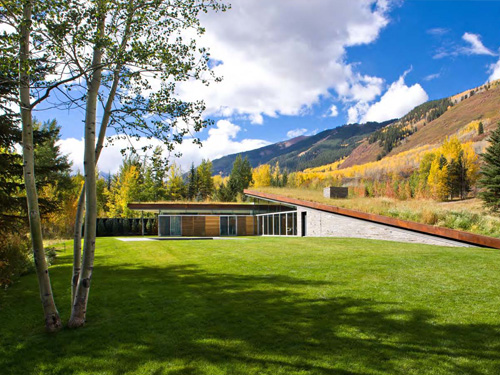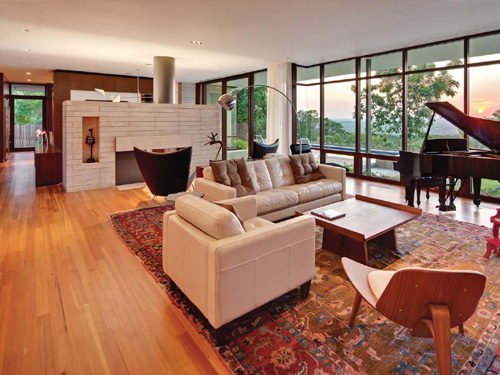The American Institute of Architects has selected the six recipients of the 2013 Housing Awards. The AIA’s Housing Awards Program, now in its 13th year, was established to recognize the best in housing design and promote the importance of good housing as a necessity of life, a sanctuary for the human spirit and a valuable national resource.
The jury for the 2013 Housing Awards includes: Kathleen Dorgan, AIA, Chair, Dorgan Architecture & Planning; John Isch, AIA, RWA Architects, Inc.; R. Thomas Jones, AIA, California Polytechnic State University; Stephen Sharpe, Hon. AIA and Charles L. Travis, AIA, The Housing Studio, P.A.
The jury recognized projects in four award categories: One/Two Family Custom Housing, One/Two Family Production Housing (none selected this year), Multifamily Housing and Special Housing.
Here's a recap of the winners (all images and descriptions courtesy AIA):
Multifamily Living Category
Via Verde - The Green Way; Bronx, New York
Dattner Architects and Grimshaw Architects
This mixed-use complex provides healthy, affordable urban living for low- and middle-income residents of the South Bronx. Built on a former brownfield site, the project comprises three building types: a 20-story tower, a 6- to 13-story midrise duplex apartment component, 2- to 4-story town houses, 222-unit complex includes.
Large windows, typically on two exposures, allow cross-ventilation and provide abundant daylighting. The garden begins as a courtyard on grade and steps up through a series of south-facing roof terraces. The terraces, many of which are accessible to residents, feature a small apple orchard and plots for growing vegetables while also providing storm water control, enhanced insulation, and mitigation of the urban heat island effect. Rainwater is collected and recycled for irrigation.
Specialized Housing Category
West Campus Housing - Phase I; Seattle
Mahlum Architects
Providing housing for 1,650 students in five buildings this project is the first phase of a student housing expansion for the university. The project has created a new walkable, transit-oriented neighborhood. To ensure the project is woven into the fabric of the city, it includes a number of publicly accessible spaces, including a 116-seat restaurant, 7,000-square-foot grocery store, café, conference center, academic support center, health and wellness center, and two retail spaces.
The exterior material palette was kept simple and economical: imperial-sized brick, white vinyl windows, wood, and weathering steel. Interior materials—mostly recycled, with no VOC content—were selected on the basis of reducing the energy required for shipping and manufacture.
One/Two Family Custom Housing Category
Eagle Ridge; Eastsound, Washington
Gary Gladwish Architecture
This project consists of a combined kitchen-dining-living area, study, master suite, art studio, and storage area, with the flexibility to add bedrooms or an apartment. To meet the client’s requirement that the house be highly efficient, it is constructed of structural insulated panels (SIPS). This method allows for a faster construction time, less waste generation, tighter construction, and better insulation. All the windows and doors are designed to surpass energy code requirements, and all of the lighting is either LED or compact fluorescent to reduce energy consumption. The siting and design of the house maximize passive solar benefits to reduce the energy load.
Halls Ridge Knoll Guest House; San Francisco
Bohlin Cywinski Jackson
The building is carefully detailed in stone, timber, and glass to respond to the site’s rolling topography, a forest of ancient live oaks and manzanita, and panoramic views of the San Clemente Mountains and Los Padres National Forest beyond. A stone wall anchors the building to the sloping site and screens the house and pool. A simple timber-framed shed roof springs from the stone wall, supporting naturally weathered zinc roofing over cedar-clad volumes. Expansive windows provide natural lighting throughout the house, and a broad overhanging roof provides shade from the intense summer sun. Sliding doors and operable hopper windows throughout the house use the prevailing winds for natural ventilation, while also providing expansive views of the mountain range.
House in the Mountains; Colorado
GLUCK+
Roof planes appear as native mountain meadows, making the structure practically invisible from the road above. These green roofs not only provide a super-insulated envelope but also preserve and highlight the original view from the existing house. Continuous clerestory windows wrap around the interior, screening out the road and revealing a spectacular mountain panorama. This clerestory creates a completely daylit space, with lighting necessary only at night. Solar panels are incorporated in the building façade. A retaining wall, clad in Cor-ten steel and cement board, slices diagonally across the site, capturing one side of the solar courtyard and, on the other, forming a private sunken court adjacent to the main living area.
Lake View Residence; Austin, Texas
Alterstudio Architecture LLP
The 5,900-square-foot house emphasizes views and a dynamic spatial sequence. A rich palette of materials on the interior, including mahogany cabinetry and longleaf pine floors, combines to create a warm environment. Oriented for optimal cross-ventilation and protection from the sun without eschewing the view westward, this project also features geothermal HVAC systems, a photovoltaic array, reflective TPO roofing, cellular foam insulation, tankless water heaters, and FSC-certified and reclaimed woods. The house also takes advantage of the tree canopy to provide additional shading, and carefully placed skylights bring diffused daylight to the interior and help reduce reliance on electric lighting.
Related Stories
Cultural Facilities | Aug 21, 2024
Baltimore’s National Aquarium opens 10,000-sf floating wetland that mimics the harbor’s original tidal marsh habitat
The National Aquarium in Baltimore has opened the National Aquarium Harbor Wetland, a 10,000-sf floating wetland that mimics the Inner Harbor’s original Chesapeake Bay tidal marsh habitat. Located between Piers 3 and 4 on Baltimore’s Inner Harbor, the $14 million project features more than 32,000 native shrubs and marsh grasses.
Mixed-Use | Aug 21, 2024
Adaptive reuse of a Sears store becomes luxury mixed-use housing
6 Corners Lofts at 4714 W Irving Park Road, Chicago, Ill., opened in March of 2024 as a 394,000-sf adaptive reuse project born out of a former Sears store.
Building Materials | Aug 19, 2024
Federal 'buy clean' construction materials label program unveiled
The U.S. Environmental Protection Agency announced a plan for implementing a new label program to boost American production of more climate-friendly construction materials and products. The label program will prioritize steel, glass, asphalt and concrete.
Museums | Aug 19, 2024
The Tampa Museum of Art will soon undergo a $110 million expansion
In Tampa, Fla., the Tampa Museum of Art will soon undergo a 77,904-sf Centennial Expansion project. The museum plans to reach its $110 million fundraising goal by late 2024 or early 2025 and then break ground. Designed by Weiss/Manfredi, and with construction manager The Beck Group, the expansion will redefine the museum’s surrounding site.
AEC Tech | Aug 19, 2024
Harnessing AI to revolutionize architectural design and creativity
Architects are wondering if AI will replace us. For Vessel, the gains offset the fear. We believe there is wisdom in the unattributed quote, “You won’t lose your job to AI. You will lose your job to someone using AI.”
Reconstruction & Renovation | Aug 19, 2024
Movement to protect historic buildings raises sharp criticism
While the movement to preserve historic buildings has widespread support, it also has some sharp critics with well-funded opposition groups springing up in recent years. Some opponents are linked to the Stand Together Foundation, founded and bankrolled by the Koch family’s conservative philanthropic organization, according to a column in Governing magazine.
Government Buildings | Aug 19, 2024
GSA posts new RFI for enabling energy efficiency, decarbonization in commercial buildings
The U.S. General Services Administration (GSA), in collaboration with the U.S. Department of Energy, recently released a new Request For Information (RFI) focused on enabling energy efficiency and decarbonization in commercial buildings. GSA wants to test innovative technologies through GSA’s Center for Emerging Building Technologies.
MFPRO+ New Projects | Aug 16, 2024
At 60 stories, the Paramount multifamily development will stand as Nashville’s tallest high rise
When complete, the 60-story Paramount building, at 750 feet high, will be the tallest high rise tower in Nashville, Tenn., surpassing the city’s current record holder, the 617-foot AT&T Building. The $390 million Paramount project recently launched condo sales after securing more than $230 million in construction financing.
Urban Planning | Aug 15, 2024
New York City begins first large-scale porous pavement installation
New York City is installing its first large-scale porous pavement installation along seven miles of roadway in Brooklyn. The project will keep 35 million gallons of stormwater out of the combined sewer system each year, according to a news release.
Urban Planning | Aug 15, 2024
The magic of L.A.’s Melrose Mile
Great streets are generally not initially curated or willed into being. Rather, they emerge organically from unintentional synergies of commercial, business, cultural and economic drivers. L.A.’s Melrose Avenue is a prime example.




